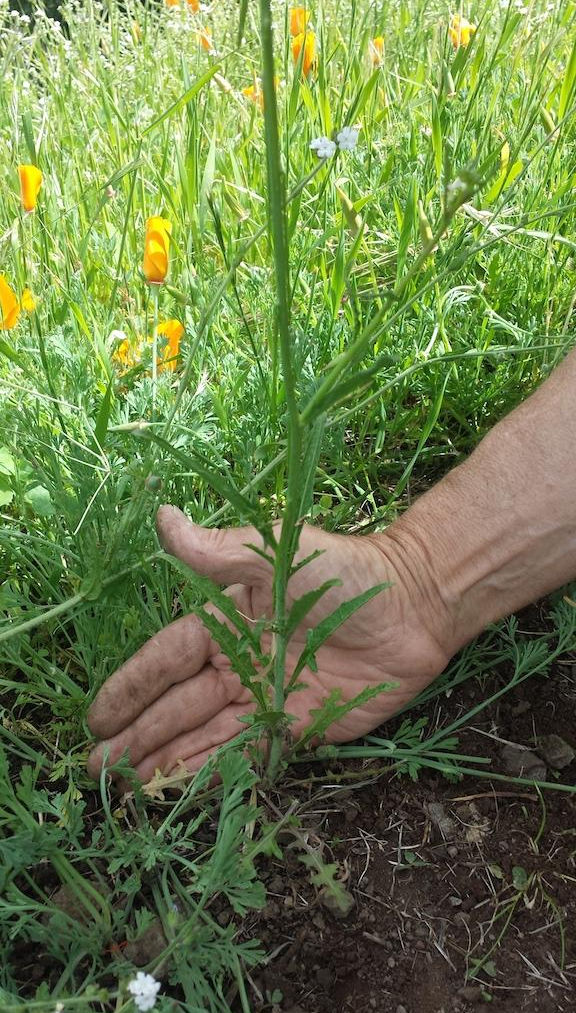
California Native Plant Society
in collaboration with East Bay Municipal Utility District
April 20, 2018
Dear Skyliners,
Weeding, weeding, weeding: we've been doing lots of close hand weeding of Six Weeks Fescue, False Brome, Wild Oats and others to button down our target areas. On Wednesday, Cynthia and I tabled at EBMUD's Earth Day event at their downtown Oakland headquarters. Wildflowers are still going very strong with late rains and cool weather. Welcome to Eric and Jenny.
We'll be out on Sunday at 9:30, and next Wednesday at 3. The grasses are just on the cusp of making viable seeds, so this is now time critical. Please let me know if you can make it. Sunday afternoon, we'll do more exploring.
Last week we found three new native plants at Skyline. This puts our count to 263. I find this quite remarkable, as we started the year with 253, and at this point, the new ones are very few and far between. The next most diverse area of our size is Claremont Canyon Preserve, with 177 natives, and then Huckleberry Preserve with 166. Skyline Gardens is a Noah's Ark of native plants, and all the creatures who depend on them.
One of the new plants is a Sedge, genus Carex. Carex are grass-like plants who usually grow in wet areas. It is the most diverse (and probably most complicated) plant genus of them all, with over 2,000 species worldwide. Lucky for us, Eric is an expert in the genus and has written a key to the Carex species in Marin County and there's a lot of overlap.
Let's meet Foothill Sedge, Carex tumulicola:

This is one of the few upland (more dry growing) Sedges, and is often grown in gardens for its tussock beauty. This clump grows right along the Skyline Trail a bit north of Diablo Bend. The word 'tumula' in Latin means mound, so that may help to remember it.
Here's a close up of the flower:

Carex have separate male and female flowers, and the way they are arranged helps sort them out. In this case, the slighly zig-zag bending of the spike is a distinctive feature. With Eric's help, we have big plans for getting to know a lot more of this group. (Thanks to Cynthia for the photos)
Next, we have California Mustard, Caulanthus lasiophylla:

This is a white-flowered native annual Mustard. We found two growing right at trail's edge at Diablo Bend, among the Poppies and Popcorn Flowers. Cynthia's magnificent art shot here probably overstates the actual presence of the plant; which is about a foot and a half tall, but the flowers are pretty small.
Here's a shot of the leaves at the base:

These are toothed and quite distinctive. The developing seed pods drop down to lie right against the stem, and that's another identifying feature.
The third new plant this week is Bigseed Biscuit Root, Lomatium macrocarpum. Here's a rosette of leaves:

At a quick glance, you might mistake this for a Poppy, but the foliage is quite leathery and very finely dissected. This species is more common in hot inland areas, like Mount Diablo and the inner Coast Ranges. Before this year, this one had not been found in the Bay Hills north of Redwood Park, and there growing on serpentine. This plant grows on the Plateau right next to the big Bay Grove. (Cynthia's photo)
Here's a shot of the flowers:

They are a lovely buff yellow and quite showy. This is a different plant of the same species, found just south of Hwy 24 in March, also on a high ridge volcanic meadow on EBMUD land. (Thanks to Damon for this photo)
When we were weeding on Sunday, we found this beautiful moth. This is Ornate Tiger Moth (Apantesis ornata):

This is a new one for me. With a quick search, I was able to find that this is a native moth of western North America. The food plants were listed as "various". Such a showy creature must have been well-studied. If anyone knows more, please let us know. (Thanks to Charlotte for this photo)
Such beauty and diversity, what an amazing world. Lucky us to be here.
Happy Trails,
Glen